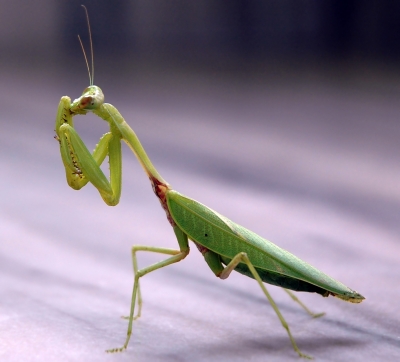
The willowy praying mantis, or mantid, can be beautiful as it folds its legs, tilts its head and looks at the world through huge eyes. But the praying mantis anatomy is designed to be a predator. Praying mantis are built to locate, hunt and subdue its prey before making short work of devouring it. With all the tools it has at its disposal, if the praying mantis were as large as a dog it would be a very dangerous creature indeed. Like most insects the body parts of a praying mantis consist of a head, abdomen, thorax, six legs and antennae with an exoskeleton.
The head of the praying mantis is an amazing construction. Praying mantises can rotate their triangular heads in almost a full circle – a feature not shared by other insects. Two antennae, or feelers, sit on top of the head and help the mantis search for food when it tilts its head or turns it from side to side. The praying mantis has five eyes total: three simple eyes that probably see only light and dark, lined along the middle of its forehead; and two compound eyes for seeing colors and images, comprising many panes aligned on either side of its head. With its ability to sense its prey, move its multi-directional head, use its excellent eyesight and move quickly and easily, the praying mantis is a very efficient and lethal predator.
The praying mantis abdomen is rounded and elongated, making up the primary part of the insect’s body. It is connected to the thorax and supports the wings and hind legs of the mantis. Like the rest of the insect, the praying mantis’ abdomen is covered with an exoskeleton, a sort of hard-shell suit of armor that provides protection, support and form.
Credit : Sciencing
Picture Credit : Google




